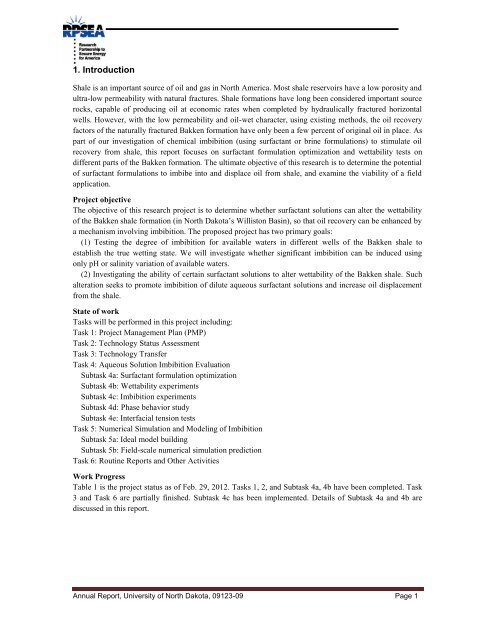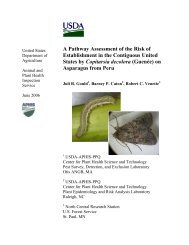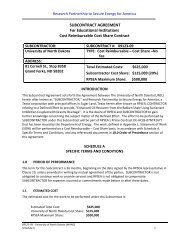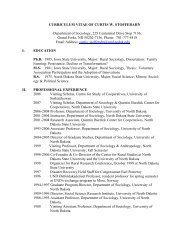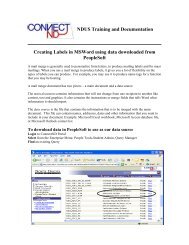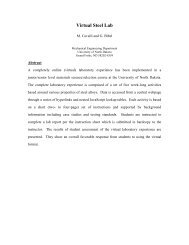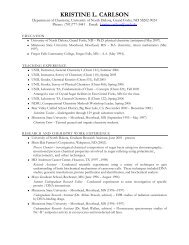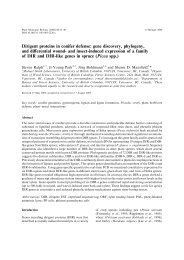Project Management Plan - Small Producers Program - University of ...
Project Management Plan - Small Producers Program - University of ...
Project Management Plan - Small Producers Program - University of ...
Create successful ePaper yourself
Turn your PDF publications into a flip-book with our unique Google optimized e-Paper software.
1. Introduction<br />
Shale is an important source <strong>of</strong> oil and gas in North America. Most shale reservoirs have a low porosity and<br />
ultra-low permeability with natural fractures. Shale formations have long been considered important source<br />
rocks, capable <strong>of</strong> producing oil at economic rates when completed by hydraulically fractured horizontal<br />
wells. However, with the low permeability and oil-wet character, using existing methods, the oil recovery<br />
factors <strong>of</strong> the naturally fractured Bakken formation have only been a few percent <strong>of</strong> original oil in place. As<br />
part <strong>of</strong> our investigation <strong>of</strong> chemical imbibition (using surfactant or brine formulations) to stimulate oil<br />
recovery from shale, this report focuses on surfactant formulation optimization and wettability tests on<br />
different parts <strong>of</strong> the Bakken formation. The ultimate objective <strong>of</strong> this research is to determine the potential<br />
<strong>of</strong> surfactant formulations to imbibe into and displace oil from shale, and examine the viability <strong>of</strong> a field<br />
application.<br />
<strong>Project</strong> objective<br />
The objective <strong>of</strong> this research project is to determine whether surfactant solutions can alter the wettability<br />
<strong>of</strong> the Bakken shale formation (in North Dakota’s Williston Basin), so that oil recovery can be enhanced by<br />
a mechanism involving imbibition. The proposed project has two primary goals:<br />
(1) Testing the degree <strong>of</strong> imbibition for available waters in different wells <strong>of</strong> the Bakken shale to<br />
establish the true wetting state. We will investigate whether significant imbibition can be induced using<br />
only pH or salinity variation <strong>of</strong> available waters.<br />
(2) Investigating the ability <strong>of</strong> certain surfactant solutions to alter wettability <strong>of</strong> the Bakken shale. Such<br />
alteration seeks to promote imbibition <strong>of</strong> dilute aqueous surfactant solutions and increase oil displacement<br />
from the shale.<br />
State <strong>of</strong> work<br />
Tasks will be performed in this project including:<br />
Task 1: <strong>Project</strong> <strong>Management</strong> <strong>Plan</strong> (PMP)<br />
Task 2: Technology Status Assessment<br />
Task 3: Technology Transfer<br />
Task 4: Aqueous Solution Imbibition Evaluation<br />
Subtask 4a: Surfactant formulation optimization<br />
Subtask 4b: Wettability experiments<br />
Subtask 4c: Imbibition experiments<br />
Subtask 4d: Phase behavior study<br />
Subtask 4e: Interfacial tension tests<br />
Task 5: Numerical Simulation and Modeling <strong>of</strong> Imbibition<br />
Subtask 5a: Ideal model building<br />
Subtask 5b: Field-scale numerical simulation prediction<br />
Task 6: Routine Reports and Other Activities<br />
Work Progress<br />
Table 1 is the project status as <strong>of</strong> Feb. 29, 2012. Tasks 1, 2, and Subtask 4a, 4b have been completed. Task<br />
3 and Task 6 are partially finished. Subtask 4c has been implemented. Details <strong>of</strong> Subtask 4a and 4b are<br />
discussed in this report.<br />
Annual Report, <strong>University</strong> <strong>of</strong> North Dakota, 09123-09 Page 1


